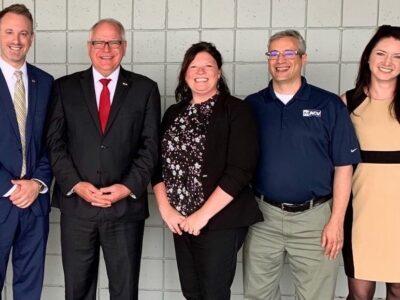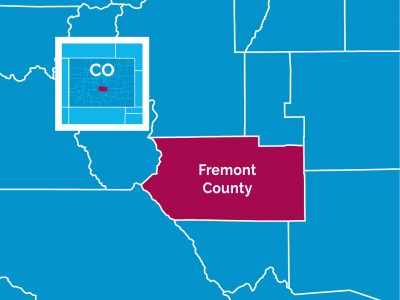Lydia Campbell recalls that five years ago, there was no reliable source of truth about who was experiencing homelessness and what their needs were at any given time across the Shenandoah region.
At that time, many homelessness providers across the area were not entering data into their homelessness database, also known as their Homeless Management Information System or HMIS.
“People could come through the front door at any one of the organizations. And it wasn’t coordinated,” said Campbell, Valley Homeless Connection Coordinator.
This incomplete picture of homelessness reflected just some of the ways that the community was not yet harnessing the full force of what it had to offer.
Campbell and her colleagues at Valley Homeless Connection were committed to changing that. They wanted to achieve a more comprehensive and real-time understanding of who is experiencing homelessness and to strengthen their system of connecting them with services that they need.
Through that process, they identified critical opportunities, challenges, and solutions, spanning provider participation, software and technology, and practices for maintaining and using the data.
Increasing provider participation
Valley Homeless Connection, a homeless service provider in the Built for Zero Community of Waynesboro, Virginia, has built a strong foundation for quality by-name data by garnering widespread provider participation, which has been instrumental in their success. Campbell drove change by advocating for providers to participate and enter data into their homelessness data system.
“We talked about how you’re already using a database to track what you do; why not use this one and everyone knows what’s happening all the time?” Campbell recalled.
They grounded these changes in their shared aim of ending homelessness and a shared value of treating the whole of the unhoused population as the responsibility of every provider.
“It is an all-of-us problem,” she said. “We also talk about why we even come to the local planning group meetings — to end homelessness. Our job is to work ourselves out of a job.”
In order for the community to be able to do this, however, people needed to change how they were supporting individuals, which included ensuring they were accounted for in the community’s by-name data. They accomplished this by stressing the importance of adding every client into the shared HMIS database. If a person experiencing homelessness was not in HMIS, they would not be included in by-name data reports either, since those reports are generated from HMIS.
“That’s helped with better data entry, honestly, particularly in my own team,” she said. “That’s also helped the community understand prioritization and make local decisions about adding priority categories based on the local need.”
Overcoming software and technology challenges
Across communities, existing software and technology are often reported as posing challenges, rather than acting as catalysts, for reducing and ending homelessness. Valley Homeless Connection experienced some challenges that Community Solutions has heard from communities over the years.
Communities often cannot readily harness the built-in reporting tools and functionalities of their Homeless Response Information System software to generate comprehensive, person-specific data, which we refer to as a community’s by-name data.
When the team initially attempted to generate a list of everyone experiencing homelessness, the software produced a lengthy list of people who had interacted with the region’s homeless response system that was not clean, reliable, or organized in a useful manner.
Like many other communities, they were hampered not only by the technical limitations of their software system, but the lack of training and resources needed to fully leverage their products as the software evolves. Even as the software company rolled out a more advanced reporting tool, Valley Homeless Connection has not been able to take advantage of the tool, due to a lack of training on how to navigate or utilize new functionalities.
Refusing to be stymied, the team has pursued some workarounds. In 2019, Community Solutions introduced the team to reports they could produce through their software that had been designed to capture inflow into homelessness, outflow from homelessness, and facilitate a meeting called case conferencing.
“What I really like about the Built for Zero reports is they export into Excel, and then I can filter by chronic status, how long someone has been experiencing homelessness, when that period began, what type of housing they’re open to, et cetera,” Campbell said.
In the Weeds: Pulling data from HMIS
Valley Homeless Connection currently uses a “casting the net wide” approach for pulling data from HMIS using the Built for Zero Case Conferencing Report, which means that the report specifies many different HMIS projects to pull from to source their by-name list. In the near future, they hope to move to a streamlined approach, which entails only pulling data from the Coordinated Entry project in HMIS to source their by-name lists, which should now capture everyone touching the system in the region with widespread provider participation. The team uses a different approach for their by-name list for people experiencing unsheltered homelessness. As the team cannot easily get unsheltered by-name data out of HMIS, they receive this data from their outreach worker.
Harnessing data for case conferencing
One example where this data has been crucial has been the establishment of a practice known as case conferencing.
Case conferencing refers to a recurring, problem-solving meeting, bringing key participants together to collaborate on ways to remove barriers to help house clients faster. It’s also the ethos of Built for Zero methodology in action — collaborative teams working through their real-time, by-name list of people experiencing homelessness, coordinating resources, and figuring out how to generate and measure system improvements along the way.
In the summer of 2019, Valley Homeless Connection initiated active case conferencing across the region with a focus on chronic homelessness.
Campbell recalled a Built for Zero coach asking a powerful question: “Is this an action meeting or an update meeting?”
“That really resonated with me,” she said. “It had definitely been an update meeting until that point, and that’s not what we needed.”
After a Built for Zero Learning Session, the team became committed to designing a more action-oriented case conferencing process.
Using the Built for Zero templates, Valley Homeless Connection began to generate reports of everyone experiencing homelessness to drive their case conferencing practice. Through their work to bring in partners such as staff from the county jail, the Shenandoah LGBTQ Center, Supportive Services for Veteran Families, and community health workers, the practice became successful. Eventually, the community scaled into four focused meetings dedicated to chronic, veteran, youth, and unsheltered homelessness.
In the Weeds: Staffing and Roles for Generating Case Conferencing Data
Valley Homeless Connection has two staff members with HMIS reporting licenses — Lydia and a Special Needs Housing Supervisor. These team members share the workload of running reports to generate by-name lists for the region’s focused case conferencing meetings.
Driving toward zero
Valley Homeless Connection has made significant progress in increasing provider buy-in and engagement in entering data into HMIS, which is essential for establishing a comprehensive and dynamic understanding of the population of people experiencing homelessness in the region.
With the foundation of widespread provider participation, Valley Homeless Connection has been able to leverage their Homelessness Management Information System data with Built for Zero reports that allow them to access and utilize person-specific data to facilitate case conferencing meetings, identify community needs, and advocate for additional housing programs and resources.
”I think it’s really important for communities to understand that: You’re required to use the system — so use it to its maximum capability,” Campbell said.
Valley Homeless Connection understands that making homelessness rare and brief is not a single event or a finish line — it is ongoing progress that must continually be sustained.
By preparing for the future and ensuring key responsibilities are documented and understood, organizations are well-positioned to continue to grow and make progress, even as staff and leadership changes over time.
“One of the things that’s really important to me, is that this whole system does not fall apart if I get hit by a bus,” Campbell said. “And so I have a very detailed plan for the event that I’m no longer here, and it is working. Other people are taking responsibility. The fire’s being lit in other people, and it’s amazing.”




